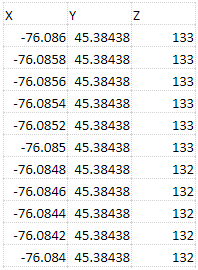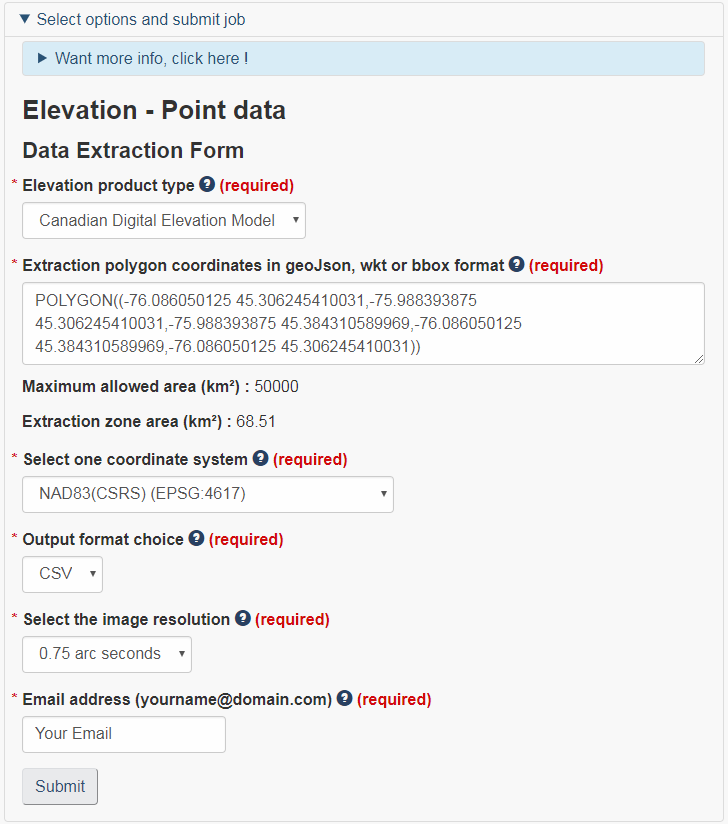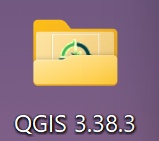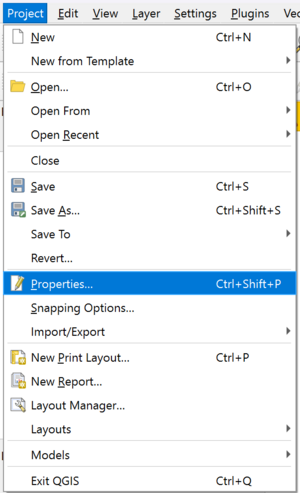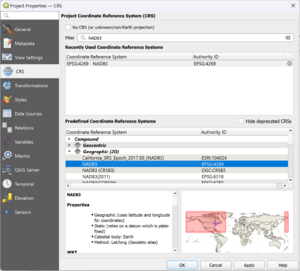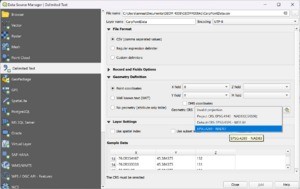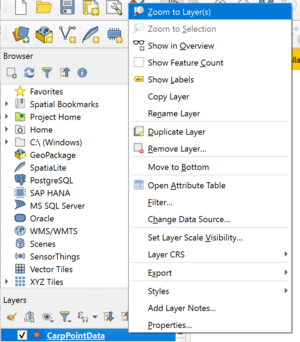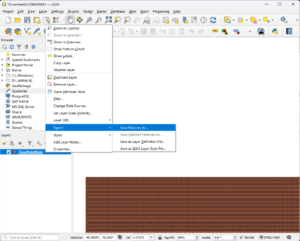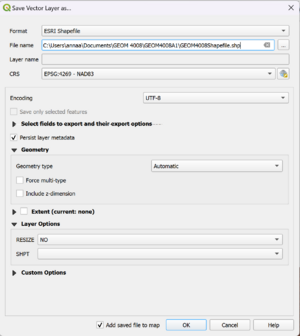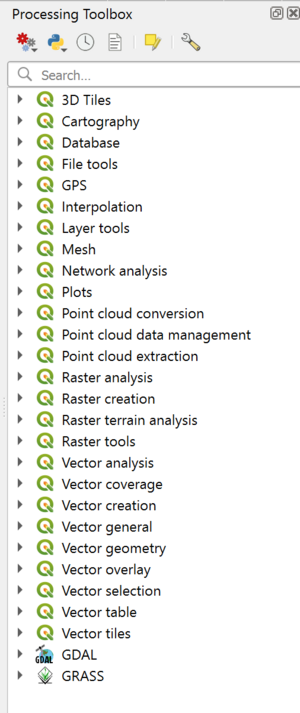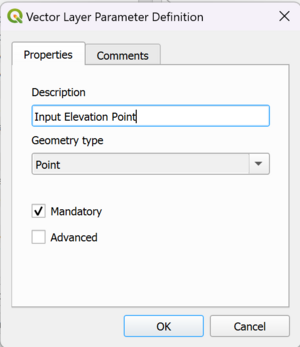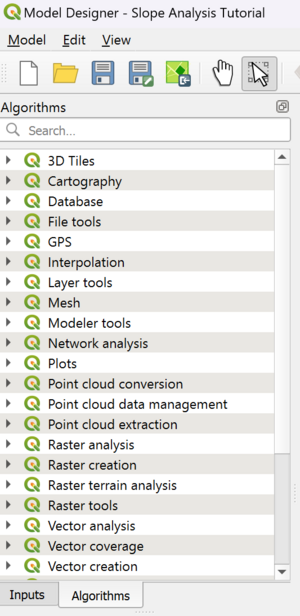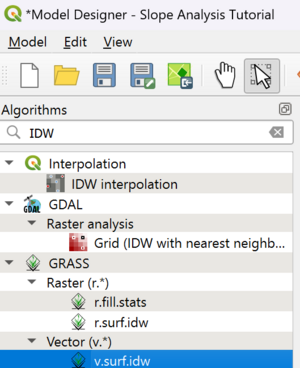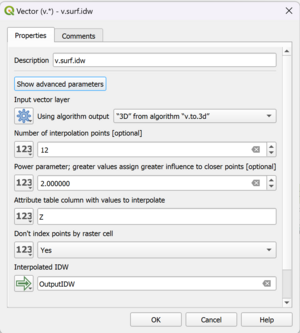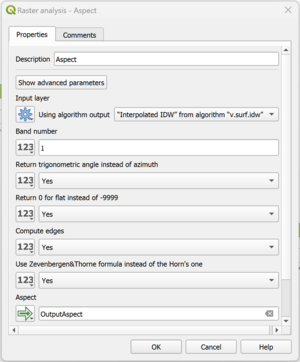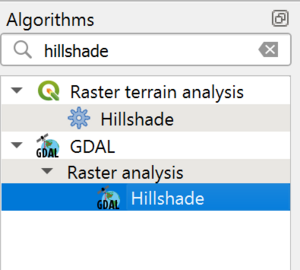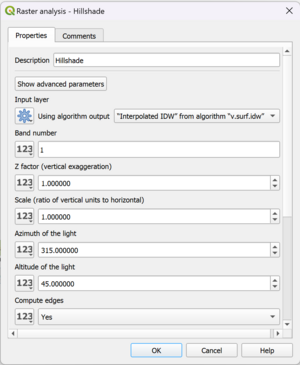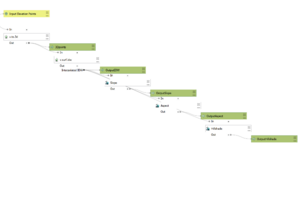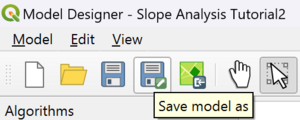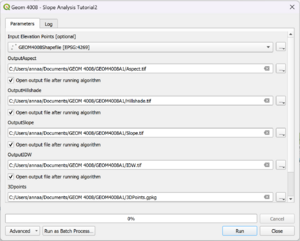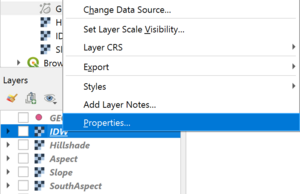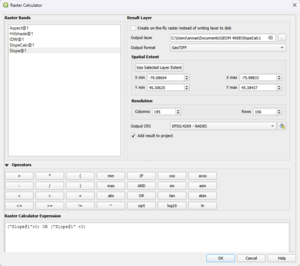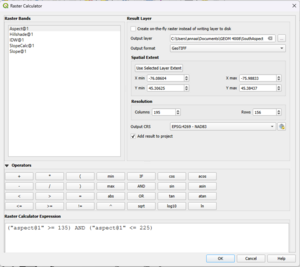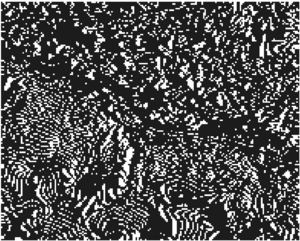Slope Analysis using Quantum GIS Processing Toolbox
Contents
- 1 Purpose
- 2 Introduction
- 3 Data
- 4 Acquiring QGIS 3.38.3
- 5 Getting Started
- 6 Processing Toolbox
- 7 Raster Calculations
- 8 Conclusion
- 9 Resource Links
- 10 References
Purpose
The purpose of this tutorial is to guide the Quantum GIS (QGIS) user through the steps necessary to create a slope analysis model workflow using the Processing Toolbox. The user will also learn the basics surrounding the creation of slope, hillshade and aspect maps. The user will also then learn how to export the model as a Python script as well as perform geoprocessing tasks using the QGIS Raster Calculator. This tutorial is designed for a beginner GIS user who has experience with previous GIS software packages however no experience with QGIS.
Introduction
QGIS is a free and open-source geographical information system application that has capabilities in viewing, editing, and geographical analysis. Users can also create and export maps with this software. Within QGIS are tools called "Plug-ins". Plug-ins are essentially developed geoprocessing features made by QGIS developers as well as independent users seeking to expand and contribute to the functionality of the software. One particular plug-in extension found in QGIS is the Processing Toolbox extension. This extension is similar to the features that are found in ArcMap’s ModelBuilder. Processing is an efficient application that is capable of creating, editing, and managing geographical models. The user is able to create workflow diagrams that connect a series of geoprocessing algorithms visually. For the purposes of this tutorial, the user will create a workflow using geographical data of Carp, Ontario in order to create a digital elevation model (DEM). This will then be used to create the slope, hillshade and aspect maps.
This tutorial was completed and revised as a partial requirement of Carleton University's Advanced Topics in Geographic Information Systems 4008 course.
Data
In this tutorial, the only necessary layer is a Comma Separated Value (CSV) point elevation file of your area of interest. We are focusing on Carp, ON. It is recommended that you use the Carp, Ontario data to follow along. It can be acquired and downloaded here. A sample of this data is shown below.
In the event that the Dropbox link has become inactive, the process of obtaining this data is described below to keep this tutorial relevant. Access the Government of Canada Geospatial Data Extraction Application here.
In the “Find a location” bar, enter “Carp” and select the following entry from those that appear:
Select the ![]() button to center the map on this location.
button to center the map on this location.
Next access the bar called “Select clipping area” and select “Current Map Extent”. Under “Select Data to be extracted” Select “Elevation – Point data”. Under “Select options and submit job” fill all of the required boxes so that it matches the figure below. Make sure to enter the email address that you would link to have the file sent to in the “Email Address” field.
An email will be sent to the entered email address shortly which contains a URL for the direct download of the data.
If neither of these options are available, since this tutorial starts with a basic csv file it can be run with any other point elevation csv file.
Acquiring QGIS 3.38.3
QGIS version: 3.38.3 (The current long-term release version of QGIS as of September 13th, 2024, is QGIS 3.38.3, and this is the version used for this tutorial. A list of the download links for all of the versions of QGIS can be found here.
Getting Started
Launching QGIS 3.38.3 and starting a Project
When the installation process has finished, an icon should appear on your desktop similar to the one shown below.
Double-click on the file icon and select the QGIS Desktop 3.38.3 application to open.
Select a new empty project from the startup menu.
Once in your project, navigate to the project tab and click "Save as". Ensure that you save your project file somewhere you will be able to find it, and give it an appropriate name.
Setting Project Coordinate Reference System (CRS)
Following the launch of QGIS 3.38.3, navigate to the top menu bar, select Project, Properties, then CRS on the left column of the popup window.
Once enabled, filter search NAD83 and select NAD83 under the Geographic Coordinate Systems (2). When finished select OK (3).
Adding Point Data
Adding the Carp elevation data or your desired .csv data requires navigating to the menu bar, select Layer and Add Layer, Add Delimited Text Layer....
In the popup window, browse for the .csv file that holds the elevation point data. Select CSV (comma separated values) for the file type. The rest of the options should default to the correct settings, but if the popup does not match the figure below, make sure that you correct these differences.
Next you will be asked to choose the projection that the data has. Under Geometry Definition, ensure that you define the proper coordinate system in which the points will be displayed. As before, filter search NAD83 and select NAD83 under the Geometry CRS (2). When finished, select OK (3).
There are two possible conversion operations within QGIS for transforming with NAD83. When prompted, choose the option with an accuracy of 2 meters, specific to Canada and offshore Newfoundland.
You should now be able to see your point data in the layers panel but your map view will not be focused on this data. Right click on the point data entry in the layers panel and select Zoom to layer.
Converting Point Data to a Shapefile
Next we will save this CSV file as a Shapfile to allow for more analysis to be done with it. Right click on the point data entry in the layers panel once again and select Export and then Save Features As.... Choose an appropriate name and file location.
In the popup that appears, set the format to ESRI Shapefile, set the file name and directory, and ensure that the checkbox beside Add saved file to map is filled. Ensure that the Geometry type is set to Automatic. Select OK once this is done.
You should now be ready for analysis!
Processing Toolbox
Open Processing Toolbox
If the Processing Toolbox is not already displayed on the right side of the QGIS 2.18.13 window, select Toolbox under Processing in the menu bar.
This will display the Processing Toolbox on the right side of the screen.
Creating a model using Graphical modeler
To create a model workflow navigate to the menu bar, under Processing, select Model Designer.
Once the modeller window has opened, you can begin to create the desired workflow. For this particular tutorial, the Carp elevation shapefile will be used to create a slope analysis workflow.
Before creating the model, you must enter a desired model name and group name with the Model Properties tab, located under the Algorythms and Inputs tabs. I named my model Slope Analysis Turotial under a group name called GEOM 4008.
Once a model and group name have been entered, select Save As and save the model to your desired folder. I would recommend creating a folder just for QGIS models under this project.
To begin your model, you'll first have to add an input parameter. On the left side of the modeller window under Inputs, select Vector Layer.
That will then display a Parameter definition window. Enter the Description as Input elevation points (or something similar), Geometry type to Point, and check the Mandatory box. Select Ok.
Now navigate to the Algorithm tab, to being adding geoprocessing algorithms.
Adding Geoprocessing Algorithms
3D transformation
The first algorithm that will be added will transform our 2-dimensional point data into a 3-dimensional dataset. This is required because by default point data in QGIS is interpreted as 2-dimensional meaning that only the X and Y values from the attribute table are considered for analysis, not the Z which is the elevation data. The algorithm used can be found by doing a search filter for 3D, and select v.to.3d under GRASS and Vector. A window will open asking for the specifications. Enter the specifications that you desire. Make sure that the Input layer is the elevation point data initially added, and that the Name of attribute column used for height is Z. Also add an Output Vector name of your choice. Select OK.
Inverse Distance Weighted (IDW)
The second algorithm that will be added is an Inverse Distance Weighted (IDW) [1]. This interpolation technique works by assuming that points closer to one another are more similar than those further apart. To predict a value for any unmeasured location, the IDW algorithm uses this assumption as well as the measured values surrounding it (ESRI, n.d.). This particular algorithm can be found by doing a search filter for IDW, and select v.surf.idw under GRASS Commands.
A window will open asking for interpolation specifications. Enter the specifications that you desire.
Make sure that the Input layer is the output from the 2D to 3D transformation.
For my slope analysis, I had to enter Z into the Attribute table column with values to interpolate field because the column under the PointDataShapefile Attribute Table used for elevation points is named Z. Also add an Output raster name of your choice.
I also used a GRASS region cellsize of 0.0005 which can be modified under Show advanced parameters. This can be changed if you'd like, although it may take longer to process with a smaller cell size value. Select OK.
Slope
Following the IDW interpolation, a slope map expressed in degrees will be created using the IDW output.
Execute a search filter for Slope, and select Slope under GDAL/OGR.
This will display a window for the Slope geoalgorithm. Leave the field parameters as default except for Slope expressed as percent to No. Make sure that the Input layer is the Interpolated IDW output.
Also add an Output raster name of your choice. Select OK.
Aspect
Execute a search filter for Aspect, and select Aspect under GDAL/OGR.
This will display a window for the Aspect geoalgorithm. Leave the specifications as default. Make sure that the Input layer is the Interpolated IDW output.
Also add an Output raster name of your choice. Select OK.
Hillshade
Execute a search filter for Hillshade, and select Hillshade under GDAL/OGR.
This will display a window for the Hillshade geoalgorithm. Leave the specifications as default. Make sure that the Input layer is the Interpolated IDW output.
Also add an Output raster name of your choice. Select OK.
Running a model
Once all of the geoprocessing algorithms have been added, the model should look similar to the capture below.
Make sure that you save the model to an appropriate place before running it.
Click the Run model button at the top of the model designer, which appears to the user as a little play button.
When the Run model button is selected, a window the same as the capture below will appear. In this window, make sure you save the output files to an appropriate destination folder. Select Run to run the model. In this window, check to make sure that your elevation point shapefile is the Input elevation points that will be transformed first in the model.
Once the model is finished running, the output layers will be displayed in the Layer toolbox on the left side.
Displaying output rasters from model
Once the model is run and the output rasters appear in the Layer toolbox. They will only appear as single band image styles.
One way to change this is to change this right click on Output IDW, select Properties.
A Layer Properties window will appear. Navigate to Symbology, select the Render type to Singleband pseudocolour. The rest of the properties can be changed to your personal desire. For my output I selected Spectral for the color and Quantile mode and then selected OK.
This process can be done for any of the output raster layers. The IDW output was done as an example. The output should look similar to the capture below, depending on the cell size used in the modeling process.
It is also possible to change the transparencies of the layers and overlay them on top of one another for more visually pleasing final maps. The following map was created by setting the transparency of the IDW layer to 10% and overlaying it onto of the Hillshade layer.
Exporting your model
Once you finish your model it can be exported for further use.
As an Image
If you'd like to print out the finished model or include it in a report it is possible to save the model as an image for future reference a picture of the model can be saved using the indicated button.
As a Python script
It is also possible to export the model as Python script using the second indicated button.
This button will display the model as a python script. From there it can be saved to an appropriate location with the Save as button. This Python script can be edited in a program such as Notepad++.
Raster Calculations
In addition to creating a model using the Processing toolbox, the "QGIS raster calculator" can be used to input certain expressions to perform multiple geoprocessing tasks.
For the purposes of this tutorial, we will start by extracting all areas from the slope map that are not flat (i.e., "don't have a slope of 0 degrees").
First navigate to the menu bar, under Raster, select Raster Calculator....
A Raster calculator window will open. Inside the raster calculator expression field, insert the expression in the image below. Remember, your expression should reflect the names you have given your output layers. If you have named your raster band differently than I have, please insert the name of your raster band in the place of mine. I would recommend manually clicking the operators to avoid typing errors. When done entering the expression, at the bottom of the window it should say "expression valid".
Remember to save the output as something that is easily recognizable, and Select OK. I named mine "SlopeCalc".
When finished, you should have an output map like the one indicated below. All areas without a slope of 0 degrees are represented in black and all other areas are in white.
Next, we are going to extract all areas from the aspect map with a south-facing slope. To account for southeast and southwest-facing slopes, I created an expression that included all slopes with aspect values ranging from 135 to 225 as "south-facing." Inside the raster calculator expression field, insert the expression in the image below. Again, your expression should reflect the names you have given your output layers. If you have named your raster band differently than I have, please insert the name of your raster band in the place of mine. Again, I recommend manually clicking the operators to avoid typing errors. Remember to save the output as something that is easily recognizable, and Select OK. I named mine "AspectCalc".
When finished, we are left with a layer where areas without aspect values between 135 and 225 are represented in black, and all other areas are in white.
Finally, we are going to create a layer which combines the two we just created. This layer will highlight areas that are not flat and are south-facing. In the raster calculator, input the expression in the image below. This combines the attributes of both layers we created in previous steps.
We are then left with a layer that highlights all sloped and south-facing areas of the raster grid in white, with all other areas in black.
The following process can be done for any of the output terrain maps.
Conclusion
In conclusion, this tutorial was aimed to give the user the skills to create workflows using the QGIS Processing Toolbox while also creating a workshop for slope and terrain analysis. This tutorial also gives the user the very basic introduction into the GIS world of Python scripting as well. The Python scripts that were exported can be slightly edited to preform the same geoprocessing tasks but with different parameters if necessary.
Resource Links
QGIS version 2.18 Documentation
GDAL - Geospatial Data Abstraction Library
Interpolation - GIS Dictionary
Python - Learn Python the Hard Way
References
Crosetto, M., Tarantola, S., & Saltelli, A. (2000). Sensitivity and uncertainty analysis in spatial modelling based on GIS. Agriculture, Ecosystems and Environment, 81(1), 71-79. doi:10.1016/S0167-8809(00)00169-9
Hutchinson, M.F., 1998. Interpolation of Rainfall Data with Thin Plate Smoothing Splines – Part II: Analysis of Topographic Dependence. Journal of Geographic Information and Decision Analysis, vol.2, no. 2, pp. 152-167, 1998.
R.E. Crochiere and L.R. Rabiner. (1983). Multirate Digital Signal Processing. Englewood Cliffs, NJ: Prentice–Hall.
ESRI, (n.d.). How inverse distance weighted interpolation works. ArcGIS Pro Help. https://pro.arcgis.com/en/pro-app/latest/help/analysis/geostatistical-analyst/how-inverse-distance-weighted-interpolation-works.htm
